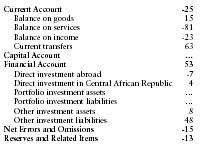Central African Republic - Balance of payments
The Central African Republic's frequent deficits in trade and services are financed mainly through international aid. In the early 1980s, the Republic faced a severe balance-of-payments problem caused by low world prices for its exports and high fuel import costs. A structural adjustment program was begun in 1986 (and further developed in 1988 and 1990) to curb the public sector and to promote private-sector investment in an effort to decrease the reliance on infusions of foreign aid. In 1998, the IMF approved a three-year structural adjustment program equivalent to $66 million (subsequently augmented and extended), which expired in 2002.
The US Central Intelligence Agency (CIA) reports that in 2000 the purchasing power parity of the Central African Republic's exports was $166 million while imports totaled $154 million resulting in a trade surplus of $12 million.
The International Monetary Fund (IMF) reports that in 1994 the Central African Republic had exports of goods totaling $146 million and imports totaling $131 million. The services credit totaled $33 million and debit $114 million. The following table summarizes the Central African Republic's balance of payments as reported by the IMF for 1994 in millions of US dollars.

| Current Account | -25 |
| Balance on goods | 15 |
| Balance on services | -81 |
| Balance on income | -23 |
| Current transfers | 63 |
| Capital Account | … |
| Financial Account | 53 |
| Direct investment abroad | -7 |
| Direct investment in Central African Republic | 4 |
| Portfolio investment assets | … |
| Portfolio investment liabilities | … |
| Other investment assets | 8 |
| Other investment liabilities | 48 |
| Net Errors and Omissions | -15 |
| Reserves and Related Items | -13 |
Comment about this article, ask questions, or add new information about this topic: